1. The project
It is by now well accepted that the ecosystem that sustains our human life is under great threat. One of the threats is the survival of the honeybee on which we crucially depend for pollination. My long-term Intelligent Beehive project researches sustainable solutions on the edge of art and science. Its goal is a double one. The inside of this bespoke beehive [Fig.1] offers a safe refuge tailored to the needs of a honeybee colony as if they were living in the wild. A co-habitation with symbiotic bacteria has a positive influence on their immune system. The outside of the hive is a biosensor that interacts with the environment. A bacterial biofilm measures the pollution of the foraging fields around the beehive by changing color when a specific threshold of fine dust is passed, because the bacteria change their internal (and hence external) state based on the degrees of atmospheric pollution that causes them stress [Fig.2]. The bacterial shield will thus reflect the information about the state of the environment, for example by changes in light, color or texture, so that the cover shield becomes a ‘sensorial skin’.
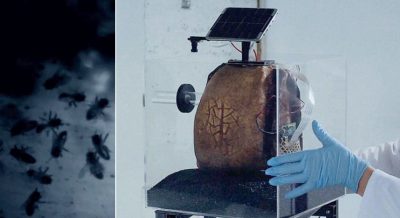
Fig.1 Research at EU Joint Research Center, Ispra (It) and UPF Barcelona,
Complex Systems Lab (2016-2017)

Fig.2 Research at Universitat Pompeu Fabra Barcelona, Complex
Systems Lab and DIY BioLab Barcelona (2016-2017)
2. The research
My recent research developed this latter aspect, namely the Sensorial Skin on the the exterior shell of the beehive. I studied the possibilities to create a shield around the beehive, a biofilm grown by cyanobacteria [Fig.3]. Photosynthetic bacteria are autotrophic, which means that they provide in their own energy. They perform photosynthesis in a similar manner to plants. They contain light-harvesting pigments, they absorb carbon dioxide, and release oxygen.
This research required an intimate interaction with a research group that is specialized in photosynthesis and has biolab and fablab facilities. With a S+T+ARTS residency grant I was able to work in professor Frese’s lab at the Vrije Universiteit Amsterdam, where photosynthetic organisms such as cyanobacteria are being probed with advanced techniques for solar electricity generation. The lab also offered the necessary biolab and fablab facilities so that the study of bacterial cultures and conducting experiments for my research became feasible. Collaboration with the Frese group was furthermore very congruent with my artistic objectives because the group has already experience with the integration of artists in their scientific practice through the ‘Hybrid Forms’ lab.
I started to study a selection of cyanobacteria species [Fig.4]. These blue-green micro-organisms had a huge impact on how our planet evolved and they contributed heavily to the biodiversity on earth, by helping to convert the earth’s early oxygen-deficient atmosphere to an oxygen-rich environment, so that new organisms that were dependent on oxygen began to emerge.
This is also why I call the artwork, that is resulting from my research, ‘L’Origine du Monde’. The title is of course also a wink towards the well known painting of the French painter Courbet.
In an actual phase, I am growing these bacteria in the form of a biofilm on a 3D printed, nutrient-rich exoskeleton that is representing the design of the beehive.
There are more possibilities to use organisms for sensing the environment. Another organism that is worth exploring is lichen. A lichen is a very sensitive composite organism that arises from cyanobacteria living among filaments of fungi in a mutualistic relationship. Lichen come in many colors and sizes. It reacts to a range of environmental compounds. The effects of these reactions are visible through changes in color or texture of the lichen. The Sensorial Skin project continues to study these several possibilities to visualise the pollution in our environment and to raise awareness about the health status of our planet.
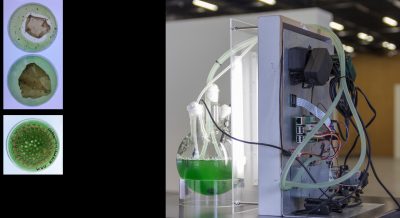
Fig.3 Growing and monitoring bacterial cultures, and tests on 3D printed shapes.
Hybrid Forms Lab, VU Amsterdam (2019-2020)
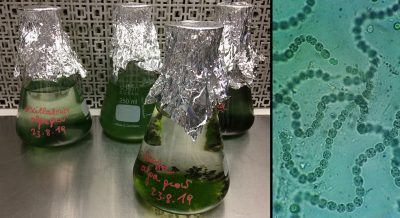
Fig.4 Monitoring of cyanobacterial cultures with the light microscope, Open BioLab
Erasmus Hogeschool Brussels (2019-2020)
Harnessing the power of algae: new, greener fuel cells move step closer to reality
3. The artwork
The installation L’Origine du Monde’ is an artistic representation of my research into the possibilities of using cyanobacteria as a source for biosensors, renewable energy and novel biodegradable materials as bioplastics.
The installation shows a strongly enlarged bacterial chain made from glass cells. Every cell is filled with cyanobacteria producing realtime photosynthesis. Together they form a complex microbial population that communicates via quorum sensing and reduces CO2 emission whilst producing oxygen and biopolymers.
Due to its nature, the Sensorial Skin can therefore be qualified as a truly innovative biological interface.
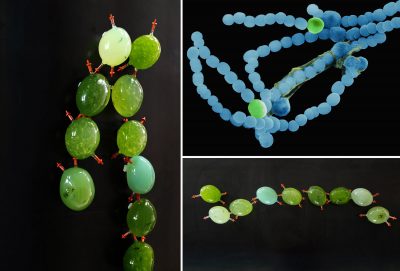
L’Origine du Monde, try-outs and SEM photography of bacterial chain. Brussels (2020)
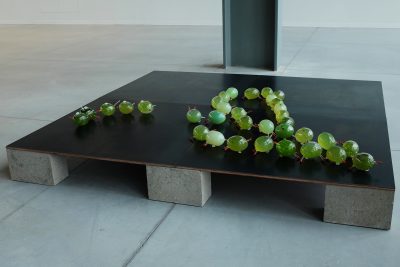
L’Origine du Monde, 35 glass cells with cyanobacteria.
Exhibition ‘New Green Deal’, Regional STARTS Kortrijk (Be)
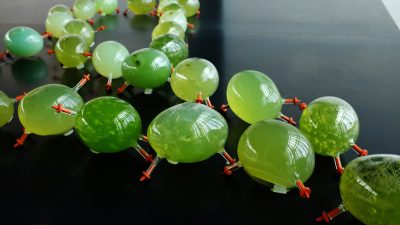
4. documentation
Overview of the Sensorial Skin for an Intelligent Beehive project (3 min.10sec.)
Overview of the research at Hybrid Forms and at Open BioLab (4 min. 48 sec.)
General introduction to the work of AnneMarie Maes (10 min. 37 sec.)
L’Origine du Monde => https://nl.wikipedia.org/wiki/Stromatoliet
Voor het ontstaan van een stromatoliet is een biofilm nodig. Dat is een laag van micro-organismen die omgeven is door een zelfgeproduceerde slijmlaag en die aan een oppervlak hecht. Bij hedendaagse stromatolieten is de biofilm 1-10mm dik en bestaat uit een basislaag van heterotrofe bacteriën, dat wil zeggen, bacteriën die van organisch materiaal leven. In de bovenlaag bevinden zich hoofdzakelijk fototrofe micro-organismen samen met een klein aantal heterotrofe. In deze laag kan onder invloed van licht nieuw organisch materiaal geproduceerd worden. Het slijm bestaat uit polysachariden en andere biopolymeren en speelt een wezenlijk rol bij het binden van sedimentdeeltjes.
